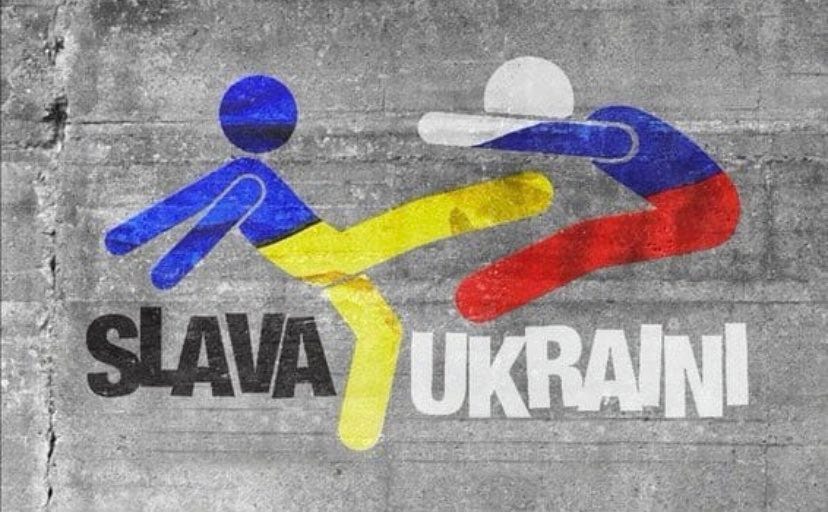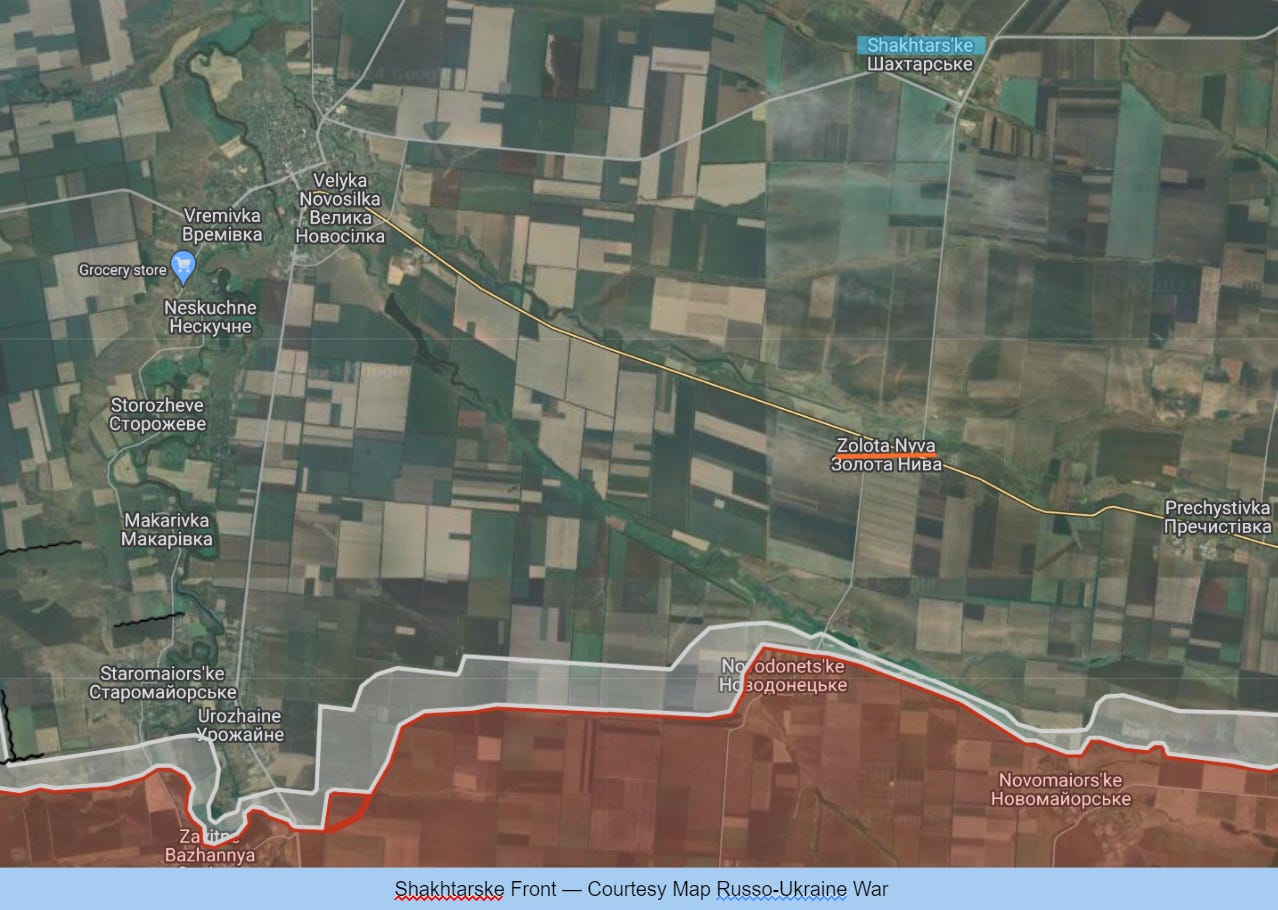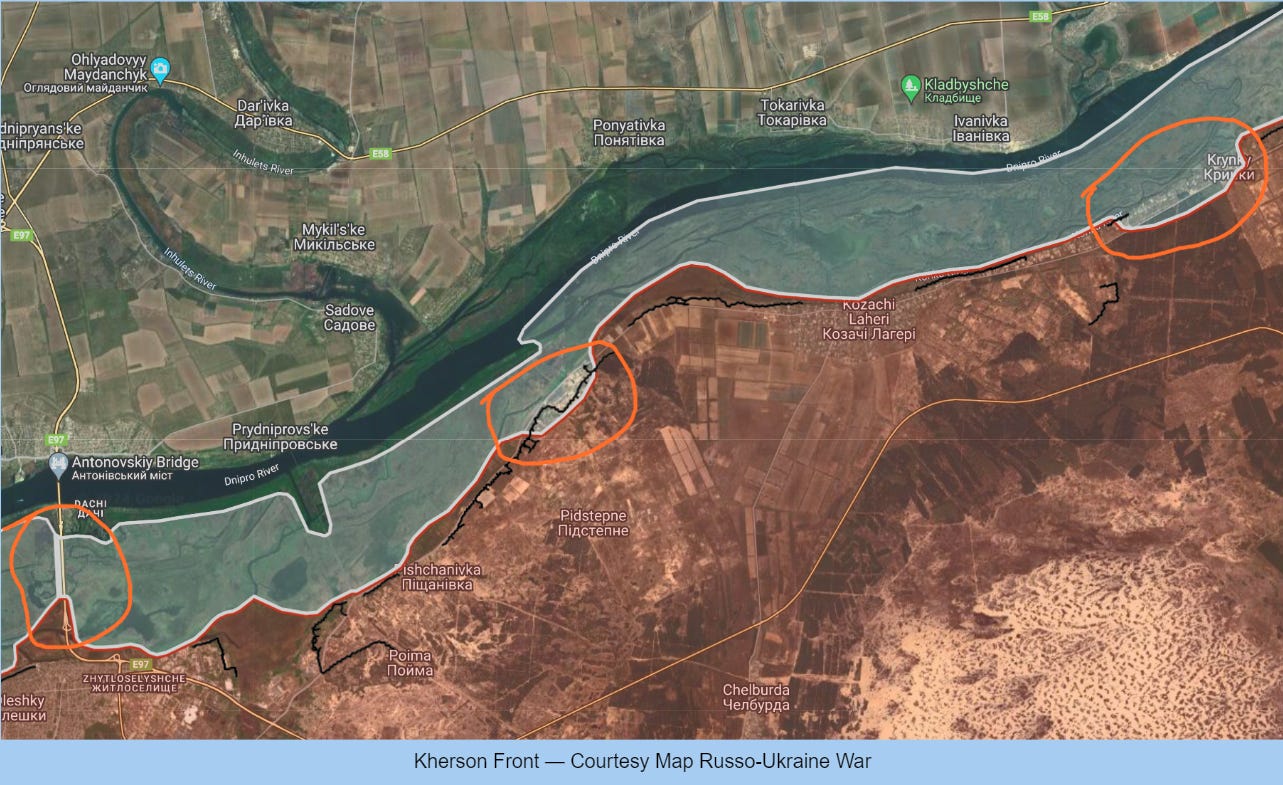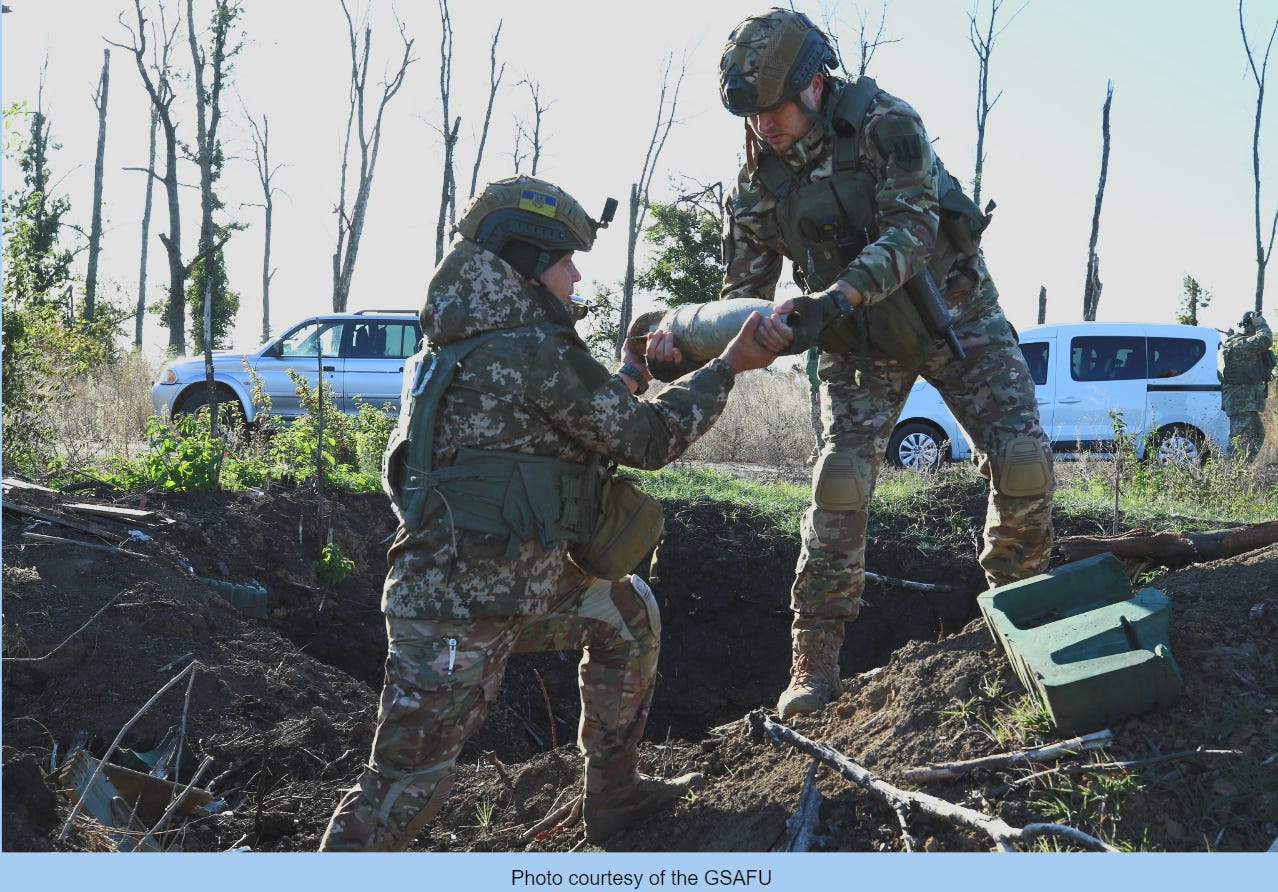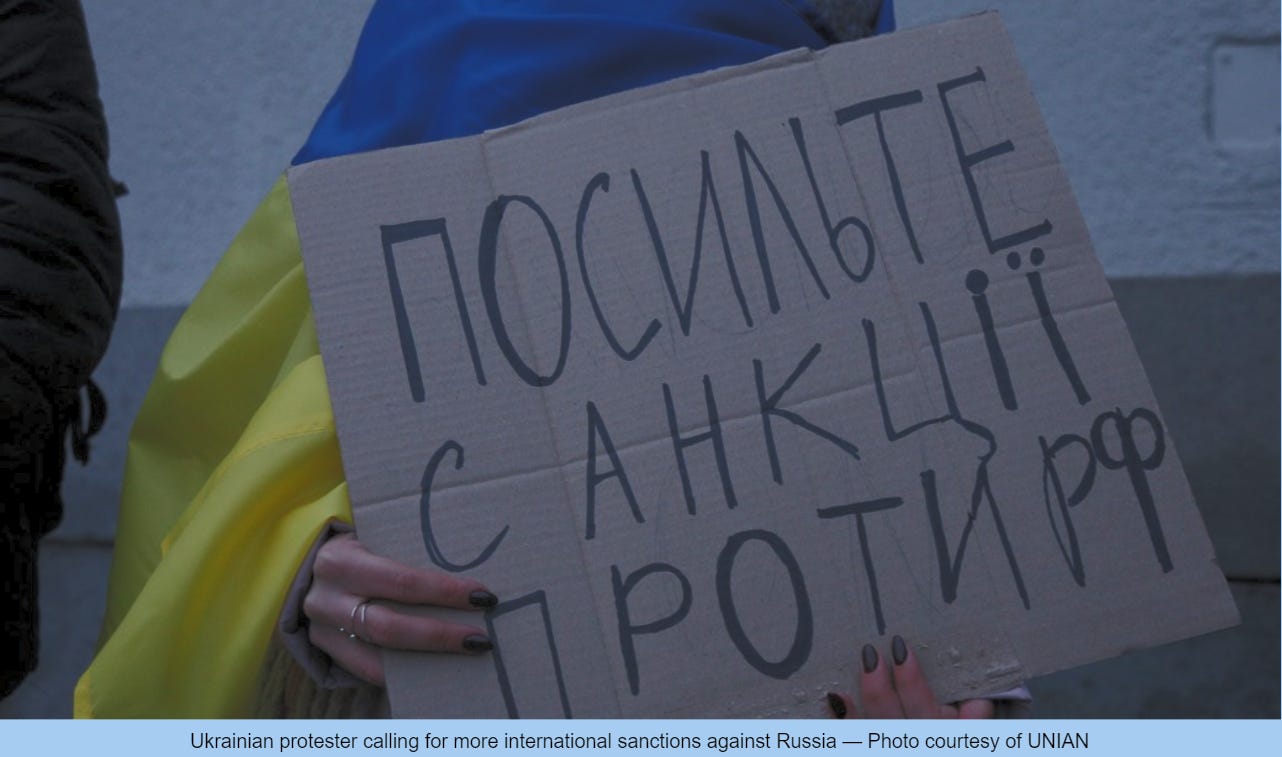Slava Ukraini! Since June 2023 I have provided a daily draft for the Ukraine War Brief Podcast collecting news from over 40 sources daily much of which ends up in the script. I will make this Draft available here for those who wish to keep up with events on a daily basis.
INSIDE UKRAINE
ALONG THE CONTACT LINE
GSAFU Morning Report
The General Staff of the Armed Forces of Ukraine in its situation update at 06:00 on Feb. 4 stated that it was day 711 of the full-scale invasion of the Russian Federation against Ukraine.
During the past day, 66 combat engagements took place. Over the past 24 hours, the enemy carried out 2 missile strikes, 65 air strikes, and 53 MLRS attacks across the positions of our troops and settlements. As a result of the Russian attacks, unfortunately, there are dead and wounded among the civilian population. Destruction and damage to residential buildings and other civilian infrastructure.
At the same time, Ukrainian soldiers continue to inflict losses in manpower and equipment on the occupying troops, exhausting the enemy along the entire front line.
"In the past 24 hours, the aircraft of the Defense Forces struck 12 areas of concentration of enemy personnel. Ukraine's air defense forces and assets destroyed a Kh-59 guided air missile, ten Shahed-136/131 attack UAVs and three reconnaissance UAVs of the enemy. Missile Force units struck an enemy troop concentration area and artillery piece,"
— GSAFU Morning Report
Week in review: A tally of Russian losses for the week of Jan. 29 - Feb 4
We here at The People’s Media keep a database of all information reported by the GSAFU in their Daily Morning Reports. We thought you might like to see the results from the last week.
In the past week there have been 504 combat engagements recorded
Russian losses were recorded as the following:
Personnel – 6,640
Tanks – 63
APVs – 147
Artillery systems – 234
MLRS – 7
Air Defence systems – 3
Aircraft -1
UAVs – 127
Cruise Missiles – 3
Warships – 1
Vehicles & fuel tanks – 290
Special equipment - 43
We would like to note all of this was for no appreciable tactical or strategic gain.
Russian Air Force ineffective in providing close air support due to the desire of aircrew to avoid risks
The UK Ministry of Defence in its Feb. 3 Intelligence Update stated following the most recent downing of a Russian SU-34 by Ukraine that Tactical aviation formations of the Russian Air Force struggle to provide consistent support to Russian ground troops. The introduction of glide kits onto crude weapon systems is likely indicative of their desire to avoid risk, allowing the aircraft to remain even further away from threats and the troops they are supporting.
Overall, it highlights the success of the Ukrainian Air Defense units and underlines the continued inability of the russian Air Force to gain air superiority.
The Khortytsia operational-strategic group is responsible for the Kup’yans’k, Lyman, and Bakhmut axes, in the northeastern part of Ukraine.
Kup’yans’k axis: Ukrainian defenders repelled 5 attacks of the enemy near the settlements Synkivka of Ivanivka (Kharkiv oblast)
Lyman axis: Ukrainian defenders repelled 8 attacks near Terny, Yampolivka (Donetsk oblast) plus the Serebrianke Forest and Klishchiivka (Donetsk oblast)
Bakhmut axis: Ukrainian forces repelled 3 attacks near Bohdanivka and Klishchiivka (Donetsk oblast)
The Tavria operational-strategic group is responsible for the Avdiivka, Mar’inka, Shaktars’ke, and Zaporizhzhia axes, in the central-eastern and southeastern part of Ukraine.
Avdiivka axis: Ukrainian defenders continue to hold back the enemy who keeps trying to encircle Avdiivka. AFU soldiers are standing their ground and inflicting major losses on the invaders. Ukrainian Defense Forces repelled 27 enemy attacks near Avdiivka, and 3 near Pervomais’ke and Nevel’s’ke (Donetsk oblast).
Mar’inka axis: Ukrainian Defense Forces continue to hold back the occupiers in the vicinities of Krasnohorivka, Heorhiivka, and Novomykhailivka (Donetsk oblast). Troops repelled 7 attacks in that area.
Shakhtarske axis: Ukrainian Defense Forces repelled 3 attack south of Zolota-Nyva, (Donetsk oblast)
Zaporizhzhia axis: Ukrainian Defense Forces repelled 1 attacks near Robotyne (Zaporizhzhia oblast).
Zelenskyy visited Ukrainian defenders at the front in the area of the village of Robotyne
On Feb. 4 President Zelenskyy visited the location of the 65th separate mechanized brigade of the Armed Forces of Ukraine in Robotyne, Zaporizhzhia oblast, where he talked to the defenders and presented them with state awards.
"On your shoulders is such a complex, decisive mission – to reject the enemy and win this war. I wish you this victory. I want to do everything to make this victory faster. That you are supported by relatives, loved ones and all citizens of Ukraine. All adequate people in the world understand that you have the most difficult job, and all Ukrainians are proud of you”
— Volodymyr Zelenskyy, President of Ukraine
The Odesa operational-strategic group is responsible for Kherson, Qırım, (also known as Crimea) and the Black Sea.
Kherson axis: Ukrainian defenders continue to expand the bridgehead. Despite significant losses, the enemy does not abandon its attempts to dislodge Ukrainian troops from their positions. Over the past day, the enemy carried 7 unsuccessful assaults on the positions of the Ukrainian Defense Forces.
TEMPORARILY OCCUPIED TERRITORIES
Nothing to report.
THE HOME FRONT
Ukraine continues the monumental effort of demining its territory
The GSAFU reported that from the beginning of the week from January 29 to February 04, the mining units of the State Special Transport Service detected, removed and neutralized 2478 explosive objects.
Kharkiv - 1313
Kherson - 693
Mykolaivskaya - 209
Zaporizhia - 263
Changed (verified) territory with an area of 2428,45 hectares
Kherson - 2306.19
Mykolaiv - 28,81
Kharkiv - 36.75
Zaporizhzhia - 56.70
Since the beginning of the large-scale aggression of the Russian Federation, the units of the State Intelligence Service have identified, removed and neutralized 104135 explosive objects.
The area of 58028.59 hectares has been changed (verified)
The aquariums - 21.66 hectares
Motor roads - 820.59 km
Railway tracks - 2293.68 km
Power grid lines - 435.86 km
Gazogoniv - 37.42 km
The dangerous work of the UA State Special Transport Service continues every day
The worrisome connection of the Telegram app to the Kremlin
Since the beginning of Russia’s full-scale invasion of Ukraine, Telegram has gained a significant impact on the Ukrainian audience. Nearly a million users downloaded the app in the month after February 24, 2022. Today, 88% of Ukrainians use this messenger. Nowadays, Telegram for many Ukrainians is the source of news, warnings about missiles flying close to one’s location, fundraising by volunteers, and access to uncensored information from the battlefield in each phone.
But, Ukrinform reports, is Ukrainian’s trust in this convenient tool, although it has ties to the aggressor country, justified in the context of the full-scale war?
The closed MTProto encryption protocol, the dubious jurisdiction of Telegram, the “dark” history of its financing, as well as the current ties of senior managers of the social network with Russia even after their alleged forced departure from their homeland; all this raises doubts about the veracity of official statements by the Telegram administration about the “super reliability” of their messenger.
Being closely connected with the Kremlin regime that launched a full-scale war in Europe raises concerns about whether the Kremlin will use the messenger with 800 million users as a tool in its war against Ukraine and later — in the global hybrid war against the West, implementing the Bolshevik ideology “We’ll light a fire through all the world.”
Pavel Durov, Telegram’s creator publicly dis-associates himself from any ties to the Russian authorities. He presents himself as a victim of the Putin regime, including for his political position. When in 2014, Durov announced that he refused to provide personal data of Ukrainian users of Vkontakte at the request of Russian security forces, the Kremlin completely took over Durov’s network.
Back then, Vkontakte came under the wing of United Capital Partners, which was managed by the board of directors of the Rosneft state corporation (which means the Kremlin). In December 2021, Radio Liberty reported that a controlling stake in VK (which controls, including the largest Russian social network Vkontakte) was bought by the Sogaz group, the owners of which are Putin’s friend Yuri Kovalchuk, the dictator’s nephew Mikhail Shelomov, and Gazprom. In March 2022, all foreigners left the company’s board of directors. Thus, there is no doubt of the full control of the Vkontakte social network by the Kremlin.
In 2022, a representative of Durov, in a comment to Forbes, noted that Pavel had left Russia many years ago and was not going to return. Today, Durov also holds French, UAE, and Saint Kitts and Nevis citizenship.
After the start of the full-scale invasion in 2022, Pavel Durov published a post on his page in which he assured that the privacy of users was a priority for Telegram, despite his former career and life in Russia. Although, he did not condemn Russia’s aggression then, calling the war a “tragic conflict.”
However, as aptly pointed out by Moxie Marlinspike (an American cybersecurity expert, cryptographer, co-founder of the Signal messenger, and author of the signal encryption protocol used in Signal, WhatsApp, Google Messages, Facebook Messenger, and Skype), although the Telegram team is no longer based in Russia, they may still have family members there and, therefore, be vulnerable to the Russian government.
Identifying the sources of funding for Telegram is a difficult task because the company attracts its investors privately. However, the names of some individuals and organizations that were indicated as investors in the messenger appeared in the media repeatedly.
An interesting detail: at the beginning of 2024, the Russian authorities “wrote off” the arrears of fines that they had previously imposed on Telegram and Western technology companies. The corresponding entry disappeared from the database of the Federal Bailiff Service. Telegram did not pay off any debts, assuring Reuters that they did not know why the debts were written off because the company had no assets in Russia. However, in reality, this is not the case: Telegram and Russia are still linked by money, technological resources, and people. Russia still manages to find workarounds to invest in Telegram.
A monitoring group of the information space of one of the units of the Armed Forces of Ukraine noticed in January 2024 the facts of external interference in the work of local Telegram channels of the occupied Berdiansk, Melitopol, and Mariupol. It was from there that the monitoring group obtained information about the strikes, destruction, loss of personnel, equipment, and matériel of the Russians. Suddenly, without the knowledge of the administrators of these channels, entire posts, photos and videos, comments in the channels and chats, were deleted.
During the special operation Bryansk, when, within 5 minutes, the Air Force of the Armed Forces of Ukraine destroyed 5 Russian aircraft in May 2023, all local Telegram channels closed the discussion. It is still unknown whether this happened as a result of outside interference, or if it was just an initiative of the channel administrators.
Similarly, during Prigozhin’s “campaign” against Moscow, only three of Wagner’s 15 channels, which were monitored, continued to function. There were also shutdowns in the operation of Telegram throughout Russia.
Using Telegram in a combat zone means giving Russians access to one’s geolocation, multimedia, and correspondence history, even if it was deleted. The Russians themselves confirm this. Thus, at the end of 2023, a leading Russian TV channel released a news story in which it boasted that Russian security forces had access to deleted correspondence on Telegram of detained Ukrainians.
And the very fact that Telegram and Vkontakte are one of the two social networks that the Russian leadership officially allowed its military to use says a lot.
Using a Russian information product now is like playing marked cards when the opponent fully knows your next moves. In conditions of war, this becomes not just bad form, but a problematic issue of national security.
THE RUSSIAN WORLD
Russia faces critical shortage of modern air defence systems
Andrey Kartapolov, the chair of the Russian parliament’s defense committee, has made a statement, as reported by Defence Blog, regarding the Russian army’s inability to defend St. Petersburg, the second-largest city in Russia, from attacks by Ukrainian kamikaze drones.
In his statement, Kartapolov acknowledged the significance of St. Petersburg, referring to it as the second capital and a place of great importance for Russia due to its historical and political significance. However, he pointed out that it is currently “impossible” to shield the city with an impenetrable air defense system.
Russia has faced challenges with the emergence of new Ukrainian kamikaze drones capable of striking deep into its territory at distances of up to 1000 kilometers. This is a result of the Russian army’s significant losses during its invasion of Ukraine in early 2022. These losses have exposed a critical shortage of modern air defense systems, which are even insufficient for protecting strategically vital assets.
For instance, on January 21st, a strike was carried out on an oil terminal in the port of Ust-Luga on the Baltic Sea, impacting Russia’s ability to export over 40% of its oil.
General-Colonel Kartapolov, who formerly commanded the Western Military District of the Russian army, recommended that Russian companies take the initiative to procure air defense systems independently, given the Ministry of Defense’s financial constraints.
NEWS WORLDWIDE
New package of EU sanctions will be the weakest of all
Radio Svoboda journalist Ricard Jozvyak stated on social network Twitter. "As expected: according to the statements, the next package of EU sanctions against Russia will consist only of visa bans / asset freezes of about 250 people / organizations. By the second anniversary of the full-scale invasion of Ukraine, it will be the weakest and most unambitious package of sanctions today
US House to Vote on Israel Aid Without Ukraine Funds Next Week
The US House will next week vote on a stand alone $17.6 billion Israel aid package without any Ukraine aid, Speaker Mike Johnson said Saturday. Bloomberg reports.
Johnson said the move is needed to get aid to Israel quickly in its battle with Hamas in the Gaza Strip because there is no time to consider a package that combines aid to Ukraine and Israel with US-Mexico border security provisions. That proposal is set to be released soon by the Senate after lengthy negotiations.
The Israel bill unveiled Saturday is the latest sign that House Republicans are prepared to delay action on Ukraine aid indefinitely due to disputes over US migration policy. Aid for Israel is far more popular within the House GOP than aid to Ukraine.
Johnson has said that a reported bipartisan border-security deal being finalised in the Senate is dead on arrival in the House. That deal, granting the president new powers to swiftly deport migrants, is to be attached to Ukraine and Israel aid and is slated to come up for procedural vote on Wednesday in the Senate.
MILITARY & TECH
Ukrainian Attack May Have Crushed Production Of Russia’s Deadliest Drone
Forbes reports that the Lancet has been one of Russia’s most effective weapons in its war with Ukraine, a small kamikaze drone which can find and destroy targets from 40 miles away with deadly precision. Lancets knock out Leopard tanks, artillery and even parked aircraft. Valerii Zaluzhnyi, Ukraine’s Commander-in-Chief, singled the Lancet out as a problem in his recent paper on the current military situation. Only a few appeared at first, dozens per month, but in July 2023 numbers were set to soar. Instead, something interrupted the supply.
That month Russian news media showed a video of Lancet makers Zala Aero, featuring their flamboyant CEO Aleksandr Zakharov touring a giant new production facility in a converted shopping mall on a Segway. The video showed racks of hundreds of Lancets, and one article suggested that production could increase by a factor of fifty. This looked like bad news for Ukraine. But instead of surging, Lancet strikes dropped off markedly. There was initially no clue as to what had happened.
Molfar, a Ukrainian OSINT group looking at sabotage operations in Russia, suggests that the cause may have been a well-targeted strike by Ukrainian forces.
On August 9th, Russian propaganda source TASS reported a massive explosion on the site of the Zagorsk Optical-Mechanical Plant (aka ZOMZ) in Sergiyev Posad near Moscow. They described the facility as making optical and optoelectronic devices for law enforcement, industry and healthcare. The company, established in 1935, is well known in Russia for high-quality binoculars and opera glasses, and according to ZOMZ website they also make medical equipment for diagnosing eye conditions as well as X-ray amplifiers.
The damage was considerable. Thirty people were taken to hospital, four buildings close to the center of the explosion were severely damaged and windows were blown out over a wide area. The damage extended to part of the local university, two schools, a sports complex and a store as well as thirty-eight apartments and four cars.
Witnesses claimed ZOMZ was hit by a Ukrainian drone, these were discounted by Russian propaganda – Officially the explosion was blamed on a warehouse used by fireworks company Piro Ross.
Piro Ross CEO Sergei Chankaev was arrested, but denies that the explosion was anything to do with his company. He says that there were no explosive materials in the warehouse, and the explosion had in fact originated from a different building.
Molfar found comments from witnesses on discussion boards suggesting that a drone struck ZOMZ immediately before the explosion.
“Considering the Russian practice of concealing information about attacks on Russian military facilities, it can be assumed that the explosion in the premises of the Zagorsky plant was a planned action by the Ukrainian side,” Molfar concluded
Immediately after the ZOMZ explosion, Ukrainian analyst Dmitro Snegirev told the news outlet Focus that the site was likely associated with producing components, presumably camera lenses or other optics, for the KUB and Lancet drones made by ZALA Aerospace.
The Lancet is, notoriously, filled with imported components, including the engine and flight electronics. The only items ZALA specifically claim to make themselves are the airframe, power supply and the camera. The explosion at ZOMZ may have interrupted the supply of cameras.
That’s it for today’s Draft folks if you would like to keep up with events in Ukraine daily please consider subscribing, its free!
Feel free to share this update with your friends. Heroyam Slava!






